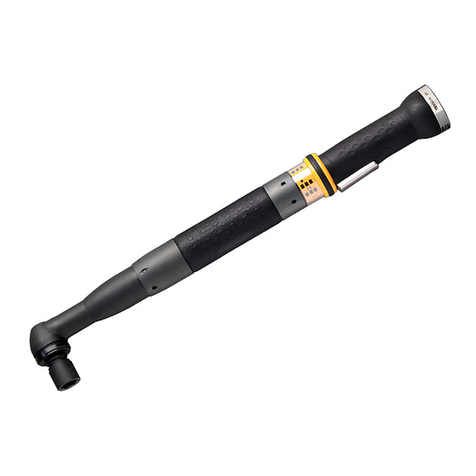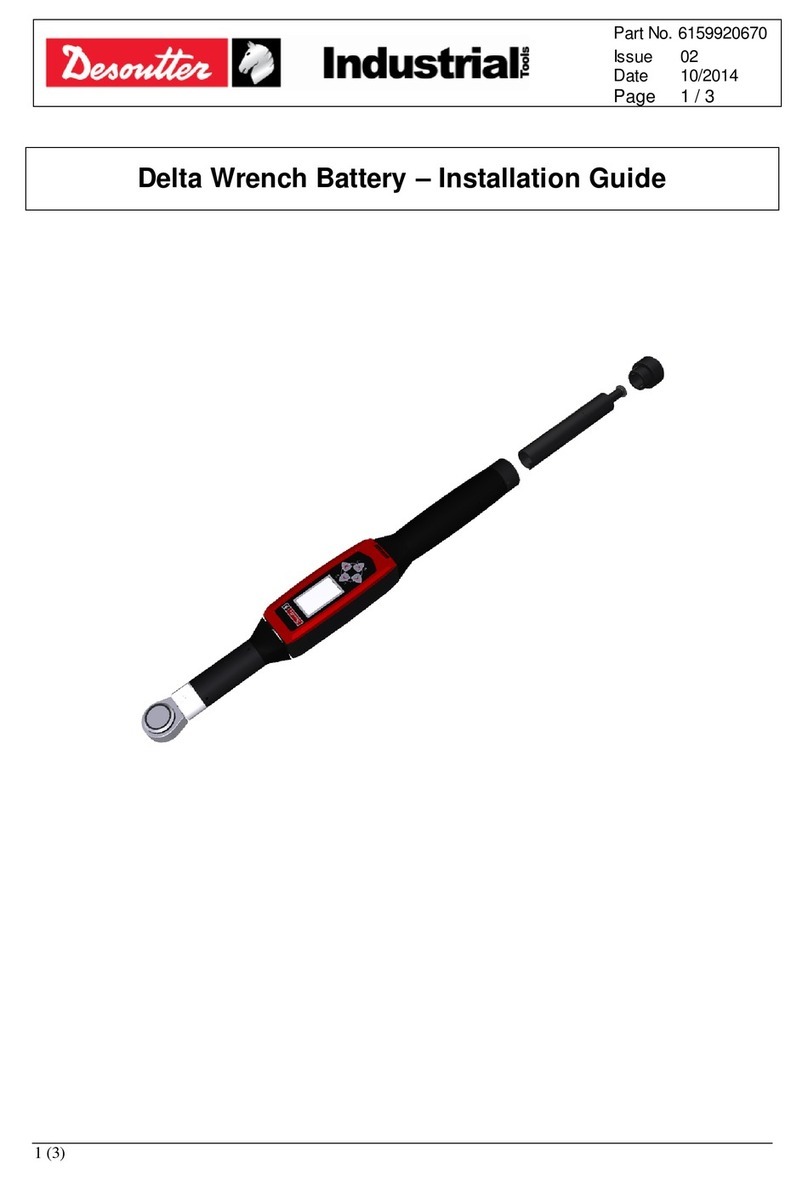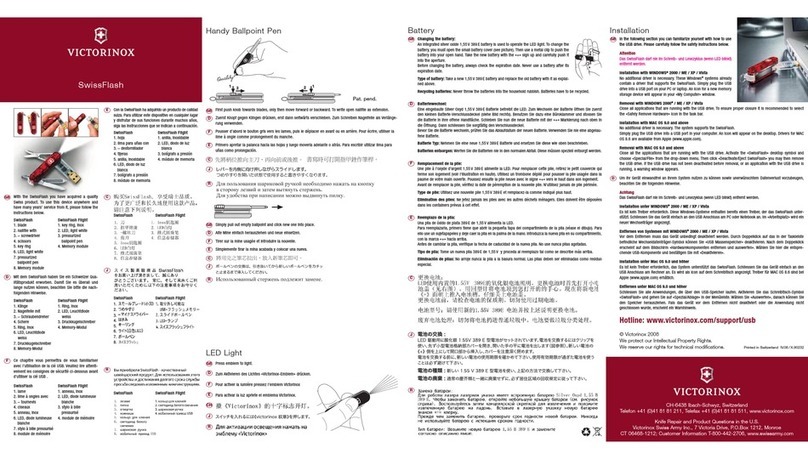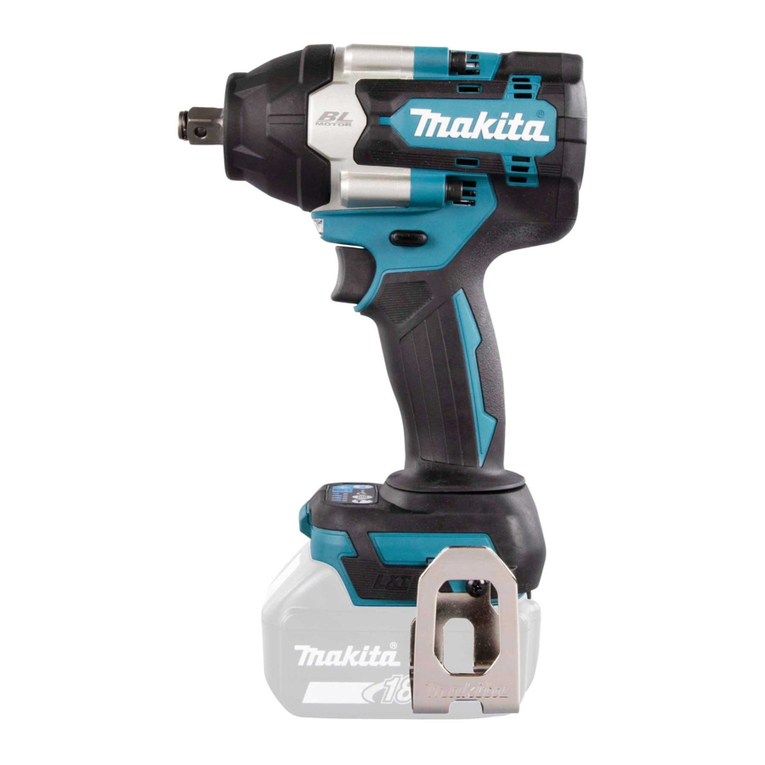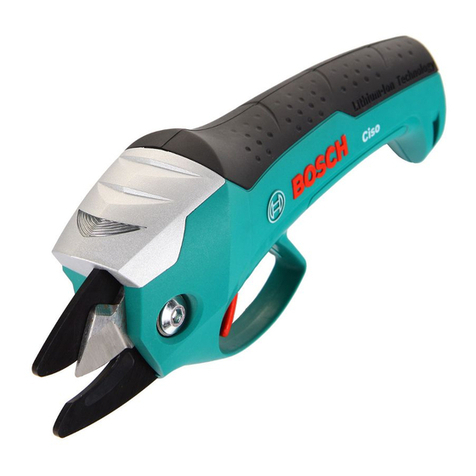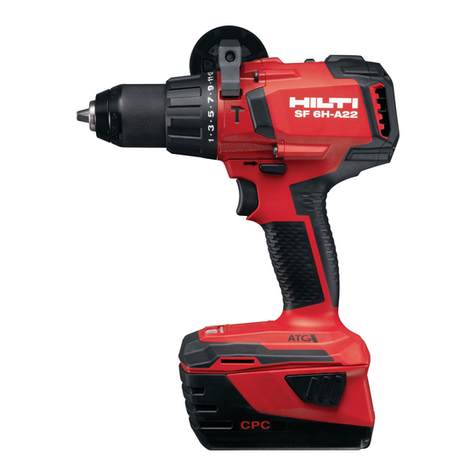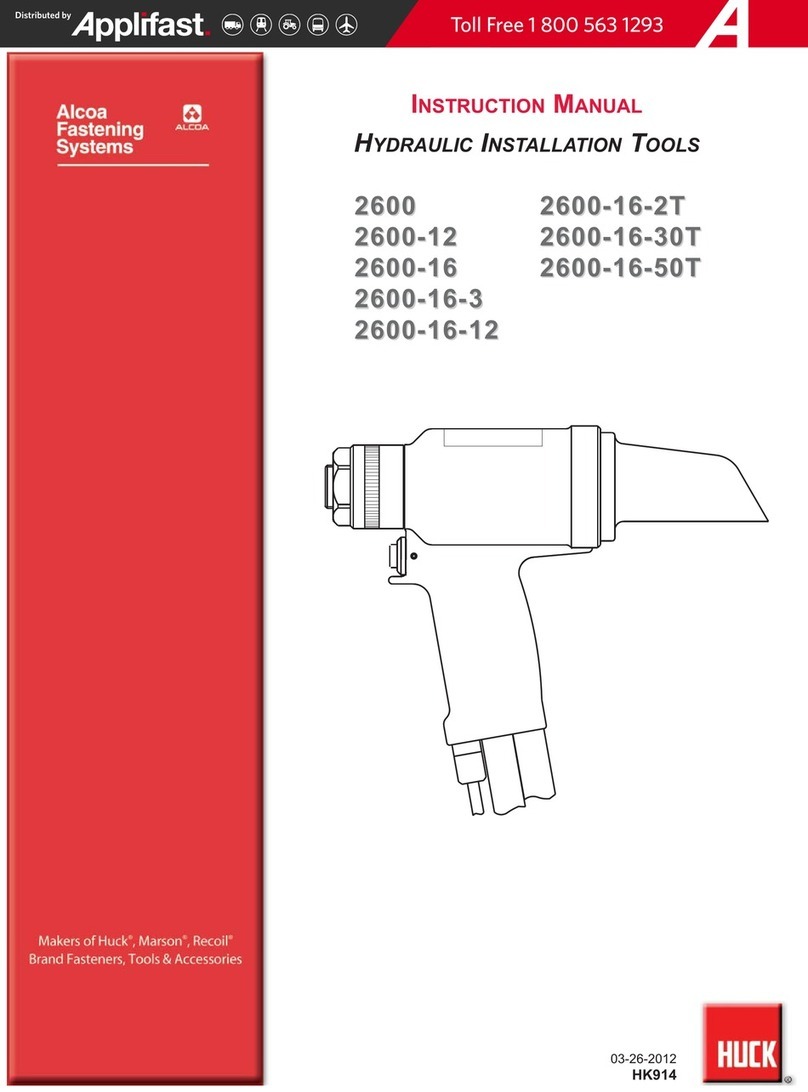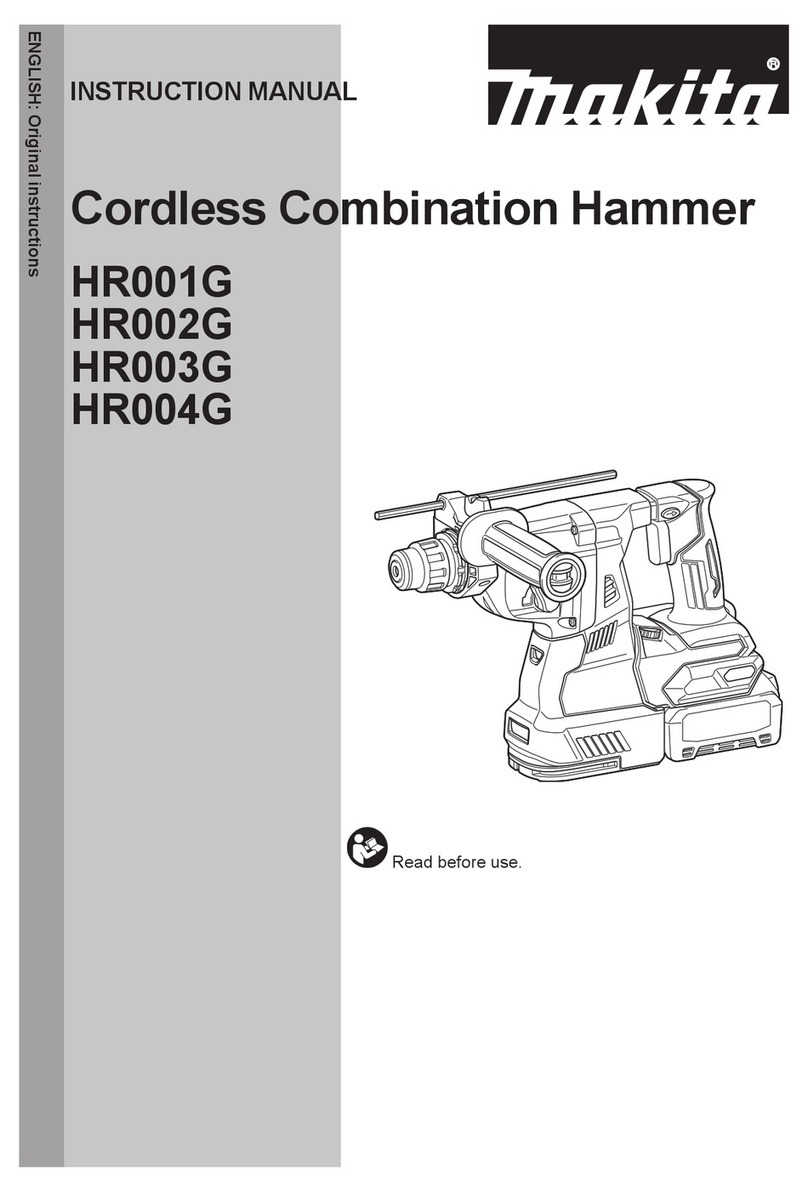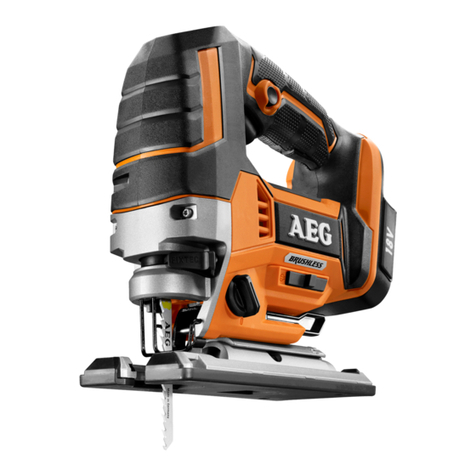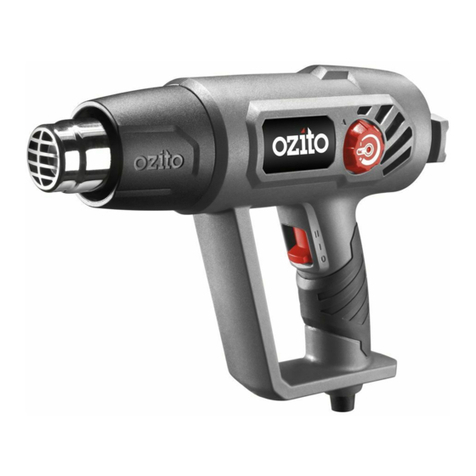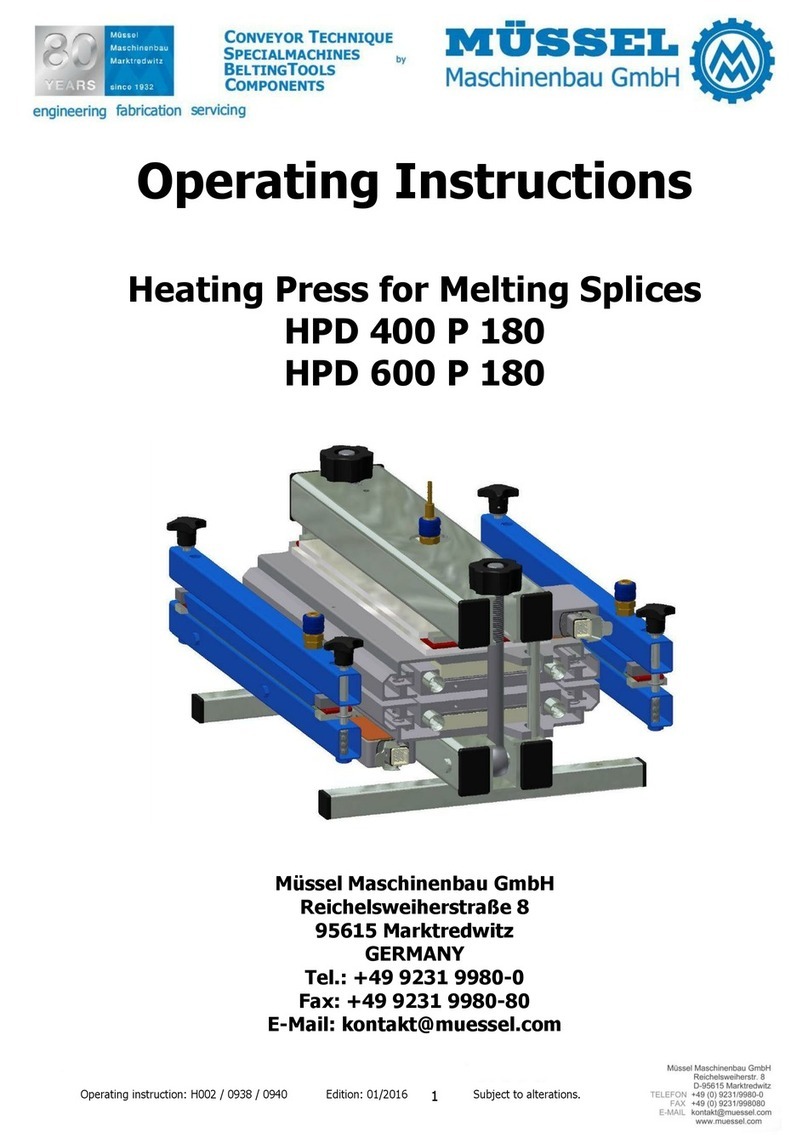Electric Dynafile 11021 Quick guide

Parts Page Reorder No. EUR-99-8
Effective May, 1999
Models:
11021 – 230V / 50Hz / 0,6 KW
11022 – Kit 230V / 50Hz / 0,6 KW Abrasive Belt Machine
Electric Dynafile®
Always operate, inspect and maintain this tool in accordance with the safety standards established by
OSHA, Underwriters Laboratories, Inc., The Canadian Standards Association and The American National
Standards Institute (ANSI). Dynabrade, Inc. assumes no responsibility for any damage or accidents
resulting from the misuse of this tool, its misapplication or nonadherence to precautionary safety measures.
WARNING
!
General Safety Rules
Read and save all instructions before operating this power tool.
Warning:
When using electric tools, basic safety precautions should always be followed to
reduce the risk of a fire, electric shock, and personal injury, including the following:
1. Keep work area clean. Cluttered areas and benches invite accidents.
2. Consider work area environment. Do not expose tools to rain. Keep
work area well lit. Do not use power tools in damp or wet locations.
Do not use tools in the presence of flammable liquids or gases.
3. Guard against electric shock. Prevent body contact with grounded surfaces.
For example; pipes, radiators, ranges, refrigerator enclosures.
4. Keep children away. Do not let visitors contact tool or extension cord.
All visitors should be kept away from work area.
5. Store idle tools. When not in use, tools should be stored in a dry, or locked
place - out of the reach of children.
6. Do not force tool. It will do a better and safer job at its intended rate.
7. Use the right tool. Do not force a small tool or attachment to do the job of
a heavy duty tool. Do not use tool for purposes not intended.
8. Dress properly. Do not wear loose fitting clothing or jewelry. Clothes can
be caught inmovingparts. Rubbergloves andnon-skidfootwear are
recommended when working outdoors. Wear protective hair covering to
contain long hair.
9. Use safety glasses. Alsouse face-shieldordust maskifoperation areaisdusty.
10. Do not abuse cord. Never carry tool by cord or yank it to disconnect from
receptacle. Keep cord from heat, oil and sharp edges.
11. Secure work. Use clamps or a vice to hold workpiece. It’s safer than using
your hand and it frees up both hands to operate tool.
12. Do not overreach. Keep proper footing and balance at all times.
13. Maintain tools with care. Keep tools clean for better use and safer
performance. Follow instructions for lubricating and changing accessories.
Inspect tool cords periodically and if damaged, have repaired by authorized
service facility. Inspect extension cords periodically and replace if damaged.
Keep handles dry, clean and free from oil and grease.
14. Do not leave tool running. Disconnect tools when not in use, before
servicing, when changing belts, contact arms, etc.
15. Remove keys and wrenches. Form a habit of checking to see that all
keys and adjusting wrenches are removed from tool before turning it on.
16. Avoid accidental starting. Do not carry around plugged in tool with finger
on switch. Be sure switch is off when plugging in.
17. Out-door use extension cords. When tool is used outdoors, use only
extension cord suitable for outdoor use. They should be marked with the
suffix W-A(for UL) or W (for CSA in Canada).
18. Stay alert. Watch what you are doing. Use common sense. Do not operate
tool when you are tired.
19. Check damaged parts. Before further use of the tool, a guard or other part
that is damaged should be carefully checked to determine that it will operate
properly and perform its intended function. Check for alignment of moving
parts, breakage of moving parts, binding of moving parts, mounting and any
other conditions that may affect its operation. Aguard or other part that is
damaged should be properly repaired or replaced by an authorized service
center unless otherwise indicated elsewhere in this instruction manual.
Have defective switches replaced. Do not use tool if switch does not
turn tool on or off.
20. Avoid gaseous areas. Do not operate portable electric tools in
gaseous or explosive atmospheres. Motors in these tools normally
spark, and the sparks can ignite fumes.
21. Do not alter or misuse tool. This tool is precision built. Any
alteration or modification not specified is misuse and may result in a
dangerous condition. Only these accessories and attachments that
are found in this instruction manual are acceptable for use with this
tool. The use ofany otheraccessoryorattachmentmight present a risk
totheoperator.
22. Replacement parts. When servicing, use only identical replacement
parts. When ordering replacement parts, please specify model and
serial numbers of your machine.
Voltage Warning
Before connecting the tool to a power source (receptacle, outlet, etc.),
be sure the voltage supplied is the same as what is specified on the
nameplate of the tool. Apower source with greater than that specified
for tool can result in serious injury to the user as well as damage to
the tool. Using a power source with voltage less than the nameplate
rating is harmful to the tool’s motor. If in doubt, do not plug in the tool.
Insulation
Electric Dynafile® is insulated according to DIN 57740/VDE 0740
and CEE-publication 20. Radio-shielded according to DIN 57875/VDE
0875 and CISPR. To protect the insulation do not drill any hole in
motor housing to fit any labels, use only stickers when it is required, to
give you added safety. Tools built with this type of insulation system are
not intended to be grounded. As a result, your Electric Dynafile® is
equipped with a two prong plug which permits you to use extension cords
without concern for maintaining a ground connection.
Note: Insulation does not take the place of normal safety precautions when
operating this tool. The insulation system is added for protection against
injury resulting from a possible electrical insulation failure within the tool.
Caution: When servicing insulated tools, use only identical replacement
parts. Repair or replace damaged cords.
Extension Cords
Insulated tools have two-wire cords, and can be used with either two-
wire or three-wire extension cords. Only round jacketed extension cords
should be used, and we recommend that they be listed by Underwriters
Laboratories (UL) - (CSAin Canada). If the extension cords will be used
outside, the cord must be suitable for outdoor use. They should be
marked with the suffix W-A(for UL) or W (for CSA in Canada). Any cord
marked as an outdoor cord can also be used for indoor work.
Important: To increase the life of the electrical motor it is absolutely
necessary to clean the inside by blowing carefully compressed air
through the ventilation channels.
Sound Level: 85 - 88 dBA.
Warning: Keep extension away from the immediate working area.
Full OneYear Warranty
Following the reasonable assumption that any inherent defect which might prevail in a product will become apparent to the user within one year from the date of
purchase, all equipment of our manufacture is warranted against defects in workmanship and materials under normal use and service. We shall repair or replace
at our factory any equipment or part thereof which shall, within one year after delivery to the original purchaser, indicate upon our examination to have been
defective. Our obligation is contingent upon proper use of Dynabrade tools in accordance with factory recommendations, instructions and safety practices. It
shall not apply to equipment which has been subject to misuse, negligence, accident or tampering in any way so as to affect its normal performance. Normally
wearable parts such as bearings, contact wheels, rotor blades, etc., are not covered under this warranty.

Important Operating and Safety Instructions
Carefully read all instructions before operating or servicing any Dynabrade®Abrasive Power Tool.
Warning: Hand, wrist and arm injury may result from repetitive work motion and overexposure to vibration.
Operating Instructions:
Warning:Eye, face and body protection must be worn while operating power tools. Failure to do so may result in serious injury or death.
Follow safety procedures posted in workplace.
1. With power source disconnected from tool, securely fasten abrasive/accessory on tool.
2. Connect power source to tool. Be careful not to switch on in the process.
3. Hold tool by the motor housing only. One or two hands may be used. Do Not hold tool by head/housing assembly. Keep hands away from all
grinding/sanding edges and moving parts.
4. Switch on to start tool, switch off to stop tool.
5. While tool is running,Adjust belt tracking by tuning 95218 RoughAdjustment Knob to the left or right accordingly, so as abrasive belt rides
evenly over contact arm.
6. Always work off the return-side of the abrasive belt. This will ensure superior tracking and reduce downtime of tool.
2
To Change Belt:
1. Disconnect power source.
2. Remove 11005/E Belt Guard by lifting up front “lip”and unhooking latches.
3Gently pull back on idler arm to expose internal workings of tool.
4. Depress idler arm lever and pll belt away from the contact wheel.
5. Slip belt over contact wheel.
To Replace Belt
1. Create a loop with belt by pinching together the sides of belt in the middle.
2. Slip one loop under the no. 12 Drive Wheel and around idler arm.
3. Depress idler arm lever and pull belt toward the contact wheel.
4. Slip belt over contact wheel, connect to power source.
5. Adjust belt tracking using 95218 Knob.
To Change Contact ArmAssembly:
1. Disconnect power source.
2. Remove 11005/E Guard by lifting up front “lip” and unhooking latches.
3Gently pull back on idler arm to expose internal workings of tool.
4. Depress idler arm lever and pull belt away from the contact wheel.
5. Slip belt over contact wheel.
6. Remove 95218 RoughAdjustment Knob.
7. Remove contact arm and replace with desired arm, making sure that
the tab on the end of the arm is facing forward.
8. Replace 95218 knob.
9. Install abrasive belt and replace belt guard.
10. Connect power source and adjust belt tracking by turning 95218 knob.
Abrasive Belt/Contact Arm Change Instructions
Grounded tools require a three wire extension cord. Double insulated tools can use either a two or three wire extension cord. As the distance from the
supply outlet increases, you must use a heavier gauge extension cord. Using extension cords with inadequately sized wire causes a serious drop in
voltage resulting in loss of power and possible tool damage. Refer to the table below to determine the required minimum wire size.
The smaller the gauge number of the wire the greater the capacity of the cord. For example a 14 gauge cord can carry a higher current than a 16 gauge cord.
When using more than one extension cord to make up the total length, be sure each cord contains at least the minimum wire size required. If you are using
one extension cord for more than one tool, add the nameplate amperes and use the sum to determine the required minimum wire size.
Guidelines For Using Extension Cords
• If you are using an extension cord outdoors, be sure it is marked with the suffix“W-A” (“W” in Canada) to indicate that it isacceptable for outdoor use.
• Be sure your extension cord is properly wired and in good electrical condition. Always replace a damaged extension cord or have it repaired by a qualified
person before using it.
• Protect your extension cords sharp objects, excessive heat and damp or wet areas.
Read and save all instructions for future reference
Nameplate Extension Cord Length
Amperes 25' 50' 75' 100' 150' 200'
0–5.0 16 16 16 14 12 12
5.1–8.0 16 16 14 12 10 –
8.1–12.0 14 14 12 10 – –
12.1–15.0 12 12 10 10 – –
15.1--20.0 10 10 10 – – –
*Based on limiting the line voltage
drop to live volts at 150% of the
rated amperes
Extension Cords
Safety Instructions:
Warning:Eye, face and body protection must be worn while operating power tools. Failure to do so may result in serious injury or death.
Follow safety procedures posted in workplace.
Important: User of tool is responsible for following accepted safety codes such as those published by theAmerican National
Standards Institute (ANSI).
•Operate machine for 30 seconds before application to workpiece to determine if machine is working properly and safely before work begins.
•Always disconnect power supply before changing abrasive or making machine adjustments.
•Inspect abrasives and accessories for damage or defects prior to installation on tools.
•Please refer to Dynabrade’s Warning/Safety Operating Instructions Tag (Reorder No. 95903) for more complete safety information.
Warning:Hand, wrist and arm injury may result from repetitive work, motion and overexposure to vibration.

95216 Pivot Pin
(for IdlerArm)
95311 Screw
95218 Knob
(For mounting contact
arm and adjusting belt tracking)
95070 Threaded Insert
Dynapad
11007 IdlerArmAssembly (Incl. 11008 IdlerArm
and (2) 11011 Idler WheelAssemblies)
11008 IdlerArm with 95070 Threaded Insert
11105/E Guard
95162 Idler Wheel Mount Screw (2)
11010 Tension Spring
(for IdlerArm)
11011 Idler Wheel BearingAssembly (2)
(Incl. 95162 Screw, 11013 Bearing and 11006 Idler Wheel.)
11040 Spring
11102/E Housing
3
Head/Housing Assembly ContactArm Assemblies
(see page 4)
40029 Cam Lock
Black
Black
Black
Red
Yellow
Yellow
Yellow Yellow
Transparent
24 23
20
19
38
29
28
27
36 37
22
13
39
40
41
26
42
18
16
15
21
14
13
3
4
5
6
7
12
9
17
Electric Motor Assembly
25
1
2
Index Key
No. Description
1 Rubber Suspension Ring
2 Bearing
3 Rotor
4 Snap Ring
5 Snap Ring
6 Bearing
7 End Plate
8 Screw
9 Aluminum Ring
12 Drive Wheel
13 Screw
14 Stator
15 Housing
16 Brush Holder
17 BrushAssembly
18 End Cape
19 Screw
Index Key
No. Description
20 Cord Clamp
21 Interference Capacitor
22 Strain Relief
23 End Cap
24 Cord and Plug Set
25 Ventilation Ring
26 Switch
27 Electronic Board
28 Potentiometer Shaft
29 Speed Regulator
36 Screw
37 Magnetic Ring
38 Adapter
39 Stranded Hook-Up Wire
40 Stranded Hook-Up Wire
41 Stranded Hook-Up Wire
42 Stranded Hook-Up Wire

Electric Dynafile®Standard Contact Arms
7/16" (11 mm)
Belt Size:
1/4" (6 mm) x 24" (610 mm) Belt Size:
1/4" (6 mm), 1/2" (13 mm) x 24" (610 mm)
Belt Size:
1/2" (13 mm) x 24" (610 mm)
Belt Size:
1/2" (13 mm) x 24" (610 mm)
Belt Size:
1/2" (13 mm) x 24" (610 mm)
Belt Size:
1/2" (13 mm) x 24" (610 mm)
11066:
5/16"(8 mm) x 1/8" (3 mm)
11027: 1/2"(13 mm)
11219
11212
11213 11228
11231
11214
11068: 5/16"(8 mm) x 3/8" (10 mm)
11070: 7/16"(11 mm) x 3/8" (10 mm)
11034: 1/4"(6 mm)
11135: 1/2"(13 mm)
11025: 1/2"(13 mm)
11080: 1" (25 mm) x 3/8"(10 mm)
11078: 5/8" (16 mm) x 3/8"(10 mm)
11084: 3/4" (19 mm) x 1/2"(13 mm)
11025: 1/2"(13 mm)
Belt Size:
1/8" (3 mm), 1/4" (6 mm) x 24" (610 mm)
Belt Size:
1/2" (13 mm) x 24" (610 mm)
Belt Size:
1/2" (13 mm) x 24" (610 mm)
Belt Size:
1/4" (6 mm) x 24" (610 mm)
Belt Size:
1/4" (6 mm) x 24" (610 mm)
Belt Size:
1/2" (13 mm) x 24" (610 mm)
11215
1/2" (13 mm) x 1/2" (13 mm)
11216
11217
9/16" (14 mm)
11232
11239
11243
11072: 7/16"(11 mm) x 1/8" (3 mm)
11074: 5/8"(16 mm) x 1/8" (3 mm)
11076: 7/16"(11 mm) x 3/8" (10 mm)
11027: 1/2"(13 mm)
11135: 1/2"(13 mm)
11086: 1" (25 mm) x 3/8"(10 mm)
11068: 5/16" (8 mm) x 3/8"(10 mm)
11084: 3/4" (19 mm) x 1/2"(13 mm)
11034: 1/4"(6 mm)
11032: 1/4"(6 mm)
11027: 1/2"(13 mm)
5/16" (8 mm) x 3/4 (19 mm)"
Belt Size:
1/2" (13 mm) x 24" (610 mm)
11218
11078: 5/8"(16 mm) x 3/8" (10 mm)
11025: 1/2"(13 mm)
11262
Belt Size:
1/2" (13 mm) x 24" (610 mm)
11078:5/8" (16 mm) x 3/8"(10 mm)
11026: 1/2"(13 mm)
DYNABRADE®
DYNABRADE EUROPE, S.àr.l. •ZoneArtisanale •L-5485 Wormeldange—Haut, Luxembourg
Phone: 352 76 84 94 •Fax: 352 76 84 95 •E-mail: [email protected] •Web Site: http://www.Dynabrade.com
11237 & 11238 Turbine Blade Arms 11255 Cross-Bow Arm
•I.D. polishing or deburring
with one 180° wrist turn.
•Deburr leading radius of
1" (25 mm) to 4" (102 mm)
round openings.
Belt Size: 1/2" (13 mm)
x 34" (864 mm).
•Grind, blend and polish turbine blades.
•Reach areas as small
as 5/16" (8 mm) wide.
11237: 1/4" (6 mm) x 24" (610 mm) belts
11066 Contact Wheel, 5/16" (8 mm) dia. x 1/8" (3 mm) wide steel.
11238: 1/2" (13 mm) x 24" (610 mm) belts.
Contact Wheel: 1/4" (6 mm) dia. x 3/8" (10 mm) wide steel (with three 11051 Bearings).
1-1/2"
38 mm
STRAP POLISH AREA
11234 Double-Burrer Arm •Deburrs both edges of
workpiece simultaneously.
•Contact wheels adjust for
material 1/8" (3 mm) to
5/8" (16 mm) thick.
Belt Size: 1/2" (6 mm) x 34" (864 mm).
11080 Contact Wheels: 1"(13 mm) dia. x 3/8" (9 mm) wide, rubber.
11257: Custom-made. To order, specify usable length up to 32" (813 mm).
Specify 11068 – 5/16" (8 mm) diameter steel, or 11078 – 5/8" (16 mm)
diameter rubber contact wheel.
11178: 9" (229 mm) reach with 11068 – 5/16" (8 mm) dia. steel contact wheel.
Belt Size: 1/2" (13 mm) x 34" (864 mm). 45 PSI / 3 Bars Max.
11179: 9" (229 mm) reach with 11078 – 5/8" (16 mm) dia. rubber contact wheel.
Belt Size: 1/2" (13 mm) x 34" (864 mm).
11257, 11178 and 11179 Spear Arms
•Up to 32" (813 mm) reach. Enter
slots as narrow as 3/8" (9 mm).
•Deburr 1/2" (13 mm) to
1" (25 mm) tubing.
11253 and 11254 Big Wheel Arms
11253 Arms (specify width)
11377 Contact Wheel: 2-1/8" (54 mm) dia. x 1/2" (13 mm) wide, urethane.
11378 Contact Wheel: 2-1/8" (54 mm) dia. x 1/2" (13 mm) wide, urethane.
11254 Arms (specify width)
11375 Contact Wheel: 4-3/4" (121 mm) dia. x 1/2" (13 mm) wide, urethane.
11376 Contact Wheel: 4-3/4" (121 mm) dia. x 1/4" (6 mm) wide, urethane.
Belt Size:
1/4" (6 mm) to 1/2" (13 mm)
x 34" (864 mm).
•Grinds and polishes deep slots or narrow groves.
•Choose 1/4" (6 mm) or 1/2" (13 mm) wide wheels in 2-1/8"
(54 mm) dia. (11253), or 4-3/4" (121 mm) dia (11254).
This manual suits for next models
1
